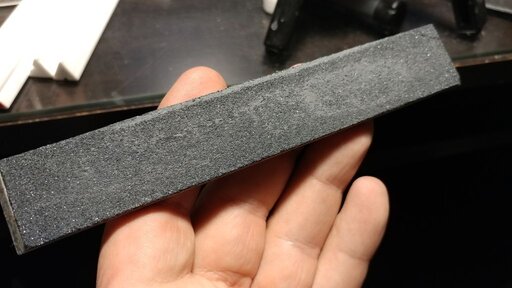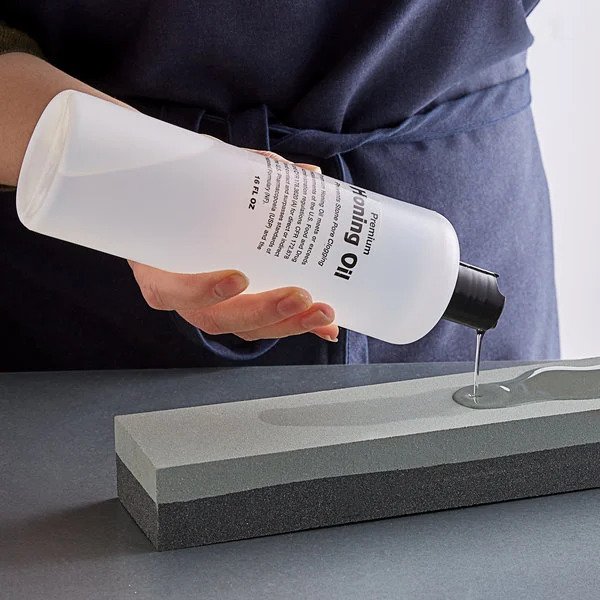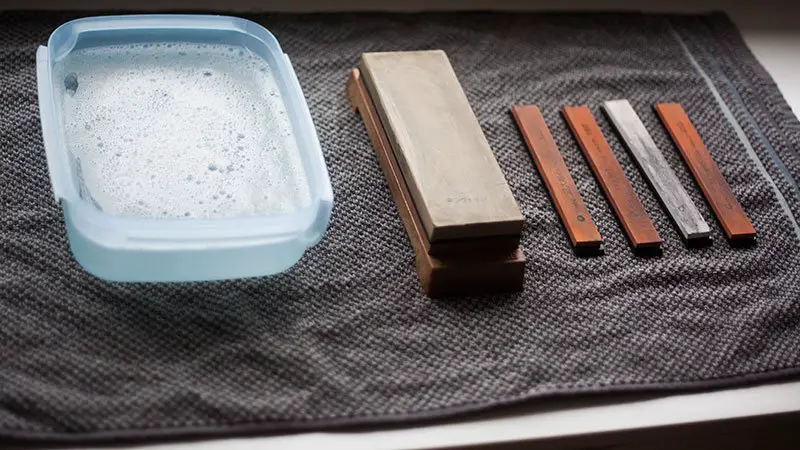If you’re a blacksmith or a professional chef, you’re familiar with knives and sharpening stones of various kinds. While the former serves us day in and day out in our kitchen, the latter helps to retain its edges.
But… What if a sharpening stone gets clogged? As annoying as it sounds, they can get clogged for numerous reasons. One being the continuous exposure to metal filings.
If you’re sharpening the knife regularly but not caring for the stones enough, they can get clogged. Also, recklessly cleaning them with water can result in cracks forming.
When dealing with the root cause of clogging, we’re only scratching the surface with these reasons. People often clean clogged sharpening stones with detergent or spraying WD-40. Yes, these are the primary tools of the trade but you need to know when and how to apply these as well.
In this article, I’ll get into the root cause of the problem and how to solve it in detail.
Why Does a Sharpening Stone Clog?

Before I go into the “Cleaning” part, let me point out some of the reasons you’ll see a stone being clogged. As subtle as it may seem, every one of these reasons contributes to a sharpening stone losing its edge.
- Most common reason for clogging would be the pores of sharpening stones. When we rub knives and other iron-made objects with these, metal fillings get inside these pores. Thanks to that, the stone will turn black in no time.
- If your knives are the dullest (we’ve all been there), one or two sessions are enough to render the stones useless.
- The second reason for clogging is “Not caring for them enough.” I’ve seen people dump their stones here and there after sharpening a steel knife. This causes dirt to clog its pores.
- Water can be venomous for these objects if people aren’t careful enough. If by any chance the stones are in contact with water for too long, it can dampen and harm the surface.
- Furthermore, the stone will absorb water over time and swell up. Sharpening knives will be a bit difficult with a soggy piece of object with not enough friction to go with it.
- Most often than not, the stone will turn a bit sticky after a few sessions. This will attract more dirt and remains of the metal. It has the chance to become spongy over time as well. This diminishes sharpening potential of these objects.
How to Clean a Clogged Sharpening Stone?
Whether due to overusing or slacking for a bit, these stones often get clogged. When it happens, you’ll need to follow a bunch of techniques to get them into working order. Here are the steps that you need to follow to clean a sharpening stone.
Place Stones in a Hot Shower
Try to soak the stone in hot water and soap. Shampoo works as well. This will loosen the hold of dirt on your stones and eventually they’ll come off.
People often go with soap and shampoo for cleaning. You can use dish-washing detergent too. Please be careful of the shape of the object as well. Cleaning it too much with using shampoos and detergent will make it lose its shape.
Use a Honing Oil for the Job

You’ll see Honing Oil being used in machine shops. Particularly, during the cleaning process of the intricate parts. For the uninitiated, this thing can be a “Mineral Oil.” Although, you’ll find vegetable honing oil as well. Honing Oil helps people in getting the debris out of any object. It also makes sure that the metallic particles released from the blades don’t adhere to the stone material. If the mineral oil seems a bit thick to you, you can always dilute it up with mineral spirits.
In this case, even from an old sharpening stone. Now, there ARE some rules as to how you’d apply it. I’ll just go over them in brief for you.
- First rule of thumb is; we don’t soak the stone in oil. Instead, we use very little of it on the surface. I’d say a quarter (or a little bit more) of it should do the trick.
- My advice would be to make small circles with the oil on the surface of the stone. People often use a clean cloth or paper towels or rag with their fingers on top for the job. I’ve also seen people using a nylon brush or a toothbrush for the job. Make sure to rub your stone in a circular motion (length-wise) with your fiber brush or whatever you’re using.
- Apply honing oil for cleaning a stone if you see metal flecks embedded in it. This will remove the flecks and grant you some much needed lubrication as well.
- Once you’re done, make sure to rinse the stone under lukewarm water. One or two minutes of rinsing with running water will do the job quite nicely. Using any kind of soap, shampoo or detergent is a big “No-No” here.
Scrub the Stone with WD40 to Remove Stingy Dirt
This oil spray is particularly good for clogged stones that are a bit older than normal. You’d need a clean cloth and a spray for this task. It’ll take just a few minutes if you’re good at applying this kerosene-based spray. Let me explain the process in detail for you.
- WD-40 cleaning spray works on almost every kind of sharpening stone we come across. Do coat your stone entirely with this oil-based solvent. However, this thing has a strong odor. Hence, please make sure that the room is well-ventilated before you apply it.
- Steel wool is a must-have for this next step. Preferably one made from 000-grade steel. Gently rub the wool all over the stone to remove all the grime. Don’t stop until you see grime come off from the surface of the stone. As I said earlier, this technique will work best on older stones.
- Use a paper towel to wipe your stone after you’re done. Don’t have a paper towel? Any damp cloth will do the trick just fine! Sometimes, wiping it once won’t do the job. Repeat the process if you have to. Make sure to wipe it till all the greasy substances come off.
Using a Flattening Stone Will Do the Trick as Well!
Honestly speaking, flattening the surface of the stones is the most effective method of removing any residue or debris. However, we’ll need a “Flattening Plate” for the job.
Simple Note: Flattening plates or lapping plates are objects we rub our stones on. One negative of these objects is that they cause sharpening stones to decay over time. This is due to regular friction.
Most often, flattening stones come with a plate. If you don’t get one, there ARE numerous products available for purchase. My recommendation? A Silicon-Carbide flattening plate.
Here are a few things that you need to keep in mind while going through the process:
- You’ll have to rub the stone back and forth. Be gentle with it. People tend to wet the plate with water. However, pay attention to the stone. If it’s a synthetic one, the plate will require honing oil rather than water.
- The plate evens out your stone’s surface. Make sure to clean it after you’re done rubbing. Otherwise, all the metal fillings will clog it as well.
- If you don’t have a plate for the job, use 100-grit wet-dry sandpaper. This will send the filings away like a plate would. However, you’ll need to grip the stone perfectly.
- Use a rubber mat to hold the stone in place while you move the stone(s) back and forth.
- Don’t sand the stone while it’s still dry.
- After you’re done, use 400-grit sandpaper to remove any scratches of in-grained filings you might leave behind on your stone.
- Try and make it a habit of flattening the stone every once in a while. I’d say, repeating the process after you’ve used the stone for 10 times is ideal. Flattening the stone for 15 seconds before using it on your plane blades and flat chisels is beneficial.
How to Prevent Sharpening Stones From Clogging?
Look, clearing debris and cleaning a clogged sharpening stone is well and good. However, preventing them before getting clogged and jammed is even better. That’s why, in this segment, I’ll tell you the ways to prevent clogging in the first place to preserve the bite.
- First of all, don’t take chances. I’d hate it if my knife sharpening stones became dry mid-sessions. That’s why I always coat them with water before and after using them on my blade.
- Don’t let the stone dry out even if you’re near the end of the sharpening session. “ALWAYS,” keep it lubricated.
- Clean the stones regularly after sharpening the knives and get rid of all the lubricants and remnants of metals amidst microscopic cracks. This will extend their lifespans saving you some money in the long run.
- Clogging prevention varies a great deal depending on what type of stones we use. Make sure to study a bit about the stones before you apply any of the tricks that I told you about.
How to Store a Clean Sharpening Stone?
Once the whetstone has done its part, it’s pretty easy to store it in a secure place. People can either stick it into a drawer wrapped in a damp cloth. This will keep it fresh for next use.
If you’ve several knife sharpening stones, feel free to hang them against a wall. It’ll ensure proper airflow when you need it. This, in turn, will take any and all sogginess out of them.
I use sharpening stones quite often. Hence, I chose to store them in water. I keep the water in Tupperware. Yes, this, very often, can promote bacteria growth. I hear you. To counter that, I add a cup full of bleach in the water. And, I do change the water on a weekly basis. Yes, it’s that simple!
However, please note you won’t be able to store oil, ceramic, and diamond stones in water.
How Long Do You Soak a Sharpening Stone?
Assuming you’re using whetstones for sharpening your knives, soaking time differs depending on how rough each stone is. Soaking reduces “Togusa” or sediment in your stones. This gives you a high-Quality edge. For medium stones, soaking in water for five minutes will do the trick.
Rougher stones need 10 minutes. You shouldn’t soak diamond-coated stones. These stones are diamond-coated on top of metal. They won’t respond kindly. Coat the diamond stone with water instead. Rinsing and brushing methods help a lot in most cases.
Finishing stones aren’t suited for water soaking as well. If soaked, these stones will form cracks. Eventually, they’ll break apart.
How Do You Clean Carborundum Stone?
These are oilstones. As we sharpen our knives, fragments of carborundum or oil stone get crushed and clog on top. Metal swarf and dryness cause carborundum to lose its efficiency.
I NEVER use oil to clean these things. Oil dries faster than water and can drag debris to the stones’ pores.
Instead, I use one tablespoon of detergent mixed with one cup of water. The solution works great in closing the pores of the object. You can use this solution as a lubricant as well. In this case, a quick rinse is all it takes.
Alternatively, when carborundum stones get clogged, soak them in Clothes Biological solution overnight before cleaning. Make sure the mixture is hot. Repeat this a couple of times and these things will be born anew!
This little tidbit can be tough even for experienced craftsmen adept at their jobs. However, do give it a try!
My Last Two Cents on the Topic
Sharpening stones are supposed to be handled with care. They’re surprisingly fragile and can have very little lifespan. Yes, even the ones coated with diamond. Ceramic sharpening stones form cracks over time if you’re not careful. That’s why you need to learn how to clean a clogged sharpening stone.
After going through my little piece on the topic, you’ll know what equipment you need for the cleaning and how to do it. While you’re at it, top up a bit on the types of sharpening stones, it’ll help you in the long run.

